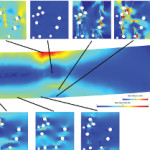Today ANSYS announced that the company is making its flagship engineering simulation software available on the cloud via Amazon Web Services. The new ANSYS Enterprise Cloud running on AWS enables customers to scale their simulation capacity – including infrastructure and software assets – on demand, in response to changing business requirements, optimizing efficiency and cost while responding to the growing demand for wider use of the technology.
OCF Builds CFD-ready Lenovo HPC Appliance
Lenovo is now offering the UK’s first ANSYS CFD-ready HPC appliance designed to ease cluster deployment while boosting engineering productivity.
FEA Simulations Bolster Designs Against Wind and Ice
The oil and gas industry depends on simulation. In this special guest feature from Scientific Computing World, Robert Roe explores how the technique can optimize the integrity of structures in extreme environments.
Mellanox Achieves World-Record ANSYS Performance
Today Mellanox announced world-record performance for ANSYS Fluent 15.0.7, exceeding previous results submitted by more than 25 percent.
New Report: Scaling Ansys in the Cloud
A newly published report by Techila Technologies and Cargotec‘s MacGregor looks at reducing the cost of ANSYS HPC system ownership with cloud services integrated to the enterprise IT.
Six Myths of HPC for Engineering Simulation, Part II
Over at the Ansys Blog, Wim Slagter has posted the second segment of his blog post six common myths about HPC for engineering simulation. “I would be really ignorant to state that it is easy to deploy and manage a HPC cluster. As a matter of fact, sizing, building, integrating, provisioning and supporting a cluster infrastructure requires highly specialized IT expertise that is often lacking users of engineering simulation software.”
Six Myths of HPC for Engineering Simulation
“A decade ago, HPC may have indeed been primarily associated with big supercomputers. However, the computer industry has delivered enormous increases in computing speed and power at consistently lower costs. Think about more compute cores per CPU, integrated I/O on processor die (yielding higher memory bandwidth), more and faster memory (channels), larger L3 cache size, faster disk storage (like solid-state drives for ANSYS Mechanical), faster interconnects, AVX support, etc. Through these advances made I can counter this myth #1 by stating that HPC is today available throughout the entire computer spectrum.”
Boosting Electric Car Batteries with Simulation
“Over the past two and half years, the team worked on a DOE-funded project, Computer-Aided Engineering for Electric Drive Vehicle Batteries (CAEBAT), to combine new and existing battery models into engineering simulation software to shorten design cycles and optimize batteries for increased performance, safety and lifespan. In order to achieve these goals the team has been modeling thermal management, electrochemistry, ion transport and fluid flow.”
Ferrari Boosts GT Endurance with Ansys
Ansys is being used to boost the endurance of Ferrari’s GT race cars.










